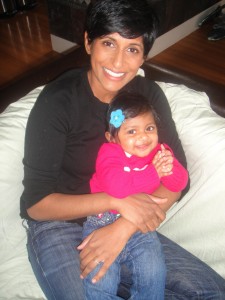Manjari Manoharan Kulkarni is a native Pittsburgher. She lives in Manhattan with her husband Rajiv, daughter Leela and dog Indiana. Manju enjoys practicing/teaching yoga, learning philosophy, eating healthy and reading. She is an orthodontist in New Jersey and enjoys making people smile!
When we discovered we were expecting, my husband and I were thrilled. To prep for the pregnancy and labor we read volumes and attended intense birthing classes. Nine months flew by and before we knew it – Baby!
However, no one told us about what happens after the baby comes. My obstetrician did allude to it when he asked if I wanted to breast feed. I simply shrugged “Yes,†and with no further information was shuffled on to the ultrasound. How I wish I was forewarned!
Breastfeeding turned out to be anything but simple. My vision of Yasoda seeing the Universe in her child’s mouth was swapped with thoughts of failure as my frustrated baby cried out in hunger. After multiple failed attempts, even our pediatrician suggested I skip directly to formula. After all, most Americans in the 1970s were raised on formula and we all turned out fine, right?
I naively believed that breast feeding would be instinctual. Evolution would prevail and baby and I would figure it out. But, years ago women learned from peers. All I witnessed was a covered woman with a baby underneath. What was going on under there?
Today’s reality is that expecting moms are bombarded with advertisements and free samples for formula. The tag lines on formula containers read “Breast milk is best, but for those that can’t, formula is almost as good.â€Â Formula was an instant solution to my problem.
Fortunately, my instinct told me not to give up. Searching for help, I found a lactation consultant. She visited my home to teach me proper positioning and encouraged me. I joined lactation clinics where I commiserated with other breast feeding challenged moms. And, I rented a hospital-grade breast pump to help boost my milk supply. In the initial weeks the physical pain and sheer exhaustion of breast feeding made child birth feel like baking cupcakes. But, after truly appreciating the benefits of breast milk, it was worth the effort. And it got easier.
Moms refer to breast milk as “liquid gold,†not just because of the effort it takes to make a few ounces, but also due to the following benefits, among others:
- A 2004 study in Lancet showed that breast fed children have 14% lower cholesterol as adults
- Another 2005 study in American Journal of Epidemiology tells finds that children who are breast fed for at least 9 months have 30% less risk of obesity.
- Breast milk contains antibodies that are passed from mother to child to help build immunity resulting in innumerable benefits
- In 2007 the American Institute for Cancer Research showed reduced risk of breast cancer in both pre and post menopausal women who breast fed for at least six months
So starting children off with breast milk gives all of us the best foundation for good health. Talk about true health care reform!
As a working mom, I invested in a portable breast pump and supplies. These items were costly, but relative to the health of my child, money well spent. In addition, employers benefit from accommodating breast pumping. Babies that are fed breast milk are healthier, resulting in a happier mom with fewer days off.
From an environmental standpoint, breast milk is locally grown (!) and has no waste when compared to the demands of producing and distributing formula. Breast feeding is an effective way for humans to reduce our carbon footprint, right from day zero.
Ultimately, the key to successful breastfeeding is a rock-solid belief in the benefits. Having a supportive husband helps too!
Remember these:
Breast pump: $$$$. More groceries for mom’s increased appetite: $$.
Lost Hours of Sleep: Too many to count. Benefits to Baby and Mom:Â Priceless
To learn more about breast feeding, benefits, and resources, visit the La Leche League website: LLLi.org.
